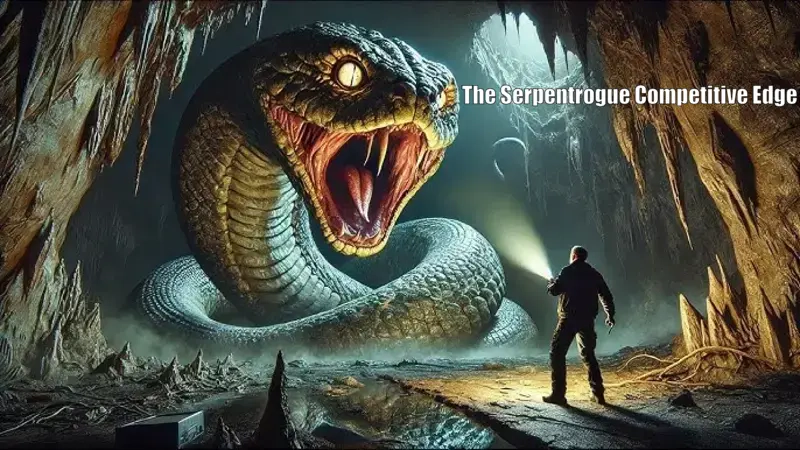In a quiet village surrounded by dark forests, a legend grew. They called it “The SerpentRogue Competitive Edge”. It wasn’t a sword or spell. It was a mindset, a way to win. Gamers whispered about it. Warriors followed its code. Entrepreneurs studied its flow. This story shows how The SerpentRogue Competitive Edge transformed lives forever.
The Legend Begins: A Young Gamer’s Struggle
A teenager named Kael lost every match. He played fast but never smart. Then he found a forgotten book. It spoke of focus, control, and adaptation. It called itself the SerpentRogue Competitive Edge. Kael studied it daily. Slowly, he began to change. He wasn’t faster—he was wiser. Every move he made now had purpose.

The Philosophy Behind the Serpent
The Serpent moves with silence. It strikes with purpose. It adapts with every threat. These became Kael’s guiding truths. The SerpentRogue Competitive Edge meant reading the field like a map. Each moment demanded awareness. Winning wasn’t about raw strength. It was about sharp instincts and calm reactions. The philosophy shaped Kael’s entire mindset.
Adaptability: The First Core Principle
Kael learned to adjust. When opponents changed tactics, so did he. Flexibility became his strength. The SerpentRogue Competitive Edge demanded he think ahead. Each challenge required a different approach. He no longer repeated old moves. He evolved. That made him deadly. Every new battle was a test. And he passed because he never stood still.
Precision: The Second Core Principle
One mistake could cost the game. Kael understood this quickly. The SerpentRogue Competitive Edge demanded sharp decisions. No rushed choices. No blind shots. He learned to pause, then strike. His aim became flawless. Every hit counted. Every second mattered. Precision turned him from average to elite. He was no longer reacting—he was predicting.
Resilience: The Third Core Principle
Kael lost many times. But he never gave up. The SerpentRogue Competitive Edge taught him that failure is a weapon. He studied his losses. He improved every time. Pain made him stronger. Setbacks shaped him. He grew calm under pressure. Resilience kept him going when others broke. That’s why he stood last, still standing.
Growth: The Fourth Core Principle
Kael didn’t stop after winning. He kept learning. The SerpentRogue Competitive Edge wasn’t a destination. It was a path. Every skill improved daily. He asked questions. SerpentRogue read strategies. He watched champions and learnt from them. Every victory opened a new door. He understood that mastery is never final. Growth became his forever goal.
The Shift: From Gamer to Mentor
Kael began to teach others. His message spread like wildfire. Students came from around the world. They asked about The SerpentRogue Competitive Edge. He taught them the four pillars: adaptability, precision, resilience, and growth. They trained hard. They won more. The mindset worked for them too. Kael’s journey became their blueprint.
The SerpentRogue in Business Strategy
Entrepreneurs saw Kael’s story. They applied his methods. SerpentRogue Competitive Edge helped them adapt to markets. Trends shifted, but they remained strong. Decisions became data-driven. They studied competitors, predicted moves, and pivoted fast. Resilience kept businesses alive in crises. Precision made products better. Growth never stopped. Business leaders credited Kael’s strategy for their edge.
The SerpentRogue in Athletics
Athletes studied Kael’s system. Coaches adopted it. The SerpentRogue Competitive Edge helped players improve their game. They moved smarter. They read opponents faster. Injuries became setbacks, not ends. Training became mindful. Precision enhanced coordination. Adaptability reshaped plays. Growth plans turned into career paths. Sports became mental and strategic, not just physical.
Personal Development: Inner Victory
People with no interest in games followed Kael too. They wanted better lives. The SerpentRogue Competitive Edge helped them manage time. They improved focus. They handled stress better. Failure didn’t break them anymore. They grew confident. They planned goals carefully. Their lives transformed because of four principles. They became stronger, smarter, and calmer.
How to Apply The SerpentRogue Competitive Edge
Start with observation. Understand your environment. The SerpentRogue Competitive Edge begins with awareness. Next, adapt. Change tactics when needed. Then, refine each move. Stay accurate. Finally, embrace growth. Learn every day. Apply the four pillars to any challenge. This strategy isn’t limited to games. It fits business, life, sports, and learning.
Tools That Amplify the Edge
Kael used journals to track progress. He watched replays. The SerpentRogue Competitive Edge encourages self-review. Use apps, tools, mentors. Build habits around growth. Set clear goals. Break tasks into pieces. Practice until skills become instinct. Don’t fear change—invite it. Keep evolving. With the right tools, progress becomes fast and lasting.
The Global Movement Begins
Kael’s story appeared online. His videos gained millions of views. The SerpentRogue Competitive Edge became a movement. Schools invited him. Tech companies hired him. He spoke at events. Every person who heard him applied his methods. Their lives improved. The world changed one learner at a time. His story touched every continent.
Critics and Doubters
Not everyone believed at first. Some said The SerpentRogue Competitive Edge was luck. Others called it hype. But Kael’s results spoke loudly. Thousands of lives improved. Scores rose. Businesses scaled. Stress lowered. Even critics admitted its power. Doubters turned into students. The proof was undeniable. The philosophy earned its respect.
The SerpentRogue Competitive Edge in Education
Teachers noticed student improvement. They used Kael’s methods in class. tRogue Competitive Edge enhanced learning. Students became curious. They engaged more. They solved problems creatively. Tests felt easier. Teachers reported better focus. Kids felt confident. Learning became fun. Schools shifted their approach. Education evolved, thanks to one idea from a video game.
Merging Mind and Motion
Gamers, athletes, and creators shared one trait—focus. The SerpentRogue Competitive Edge built this skill. Mindset meets action. Every step became thoughtful. Habits aligned with purpose. Results improved. Creativity soared. Mistakes taught lessons. Progress stayed steady. Whether on screen or in the field, the mindset was delivered. Balance of mind and body became the key to excellence.
Future of The SerpentRogue Competitive Edge
The movement continues. More industries adopt the method. Kael leads research teams now. Rogue Competitive Edge is studied in labs. It influences AI models and leadership training. Health coaches use it. Artists apply it. The next generation grows up with it. The mindset evolves, but the foundation stays strong.
Final Thoughts
What started in a bedroom became global. Kael’s journey showed that mindset shapes destiny. The SerpentRogue Competitive Edge is more than strategy. It’s a story of focus, growth, and resilience. Anyone can adopt it. Anyone can rise with it. In a chaotic world, this mindset brings clarity. The edge belongs to those who choose it.
Frequently Asked Questions
Q1: What is The SerpentRogue Competitive Edge?
It’s a four-principle mindset—adaptability, precision, resilience, and growth—applied to win in any field.
Q2: Is this strategy only for gamers?
No. It works in business, sports, education, and personal development.
Q3: How do I start applying it?
Begin with observation. Adapt fast. Practice precision. Always grow. Track your progress and improve daily.
Q4: Who created it?
The idea came from a fictional gamer’s story—Kael—used to illustrate how the mindset works.
Q5: Is this model backed by real success?
Yes. Thousands have applied it and seen measurable success across industries.
Q6: Why the serpent as a symbol?
The serpent represents stealth, intelligence, and agility—traits essential to competitive excellence.
Q7: Can this be used by students?
Absolutely. It improves focus, memory, and academic performance.
Q8: What tools help implement it?
Journals, feedback systems, data trackers, and mentorship all help.
Q9: Is it a fixed system?
No. It evolves. Its strength is adaptability.
Q10: Where can I learn more?
Look for communities online. Many trainers now offer courses based on the system.


